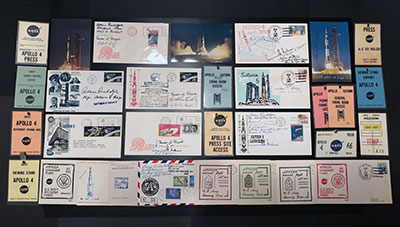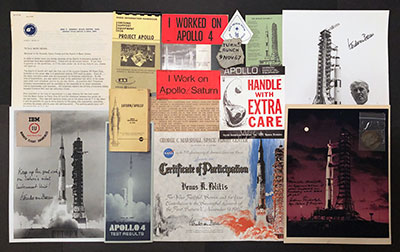Ken Havekotte
Member Posts: 2913
From: Merritt Island, Florida, Brevard
Registered: Mar 2001
|
 posted 11-07-2019 10:25 PM
posted 11-07-2019 10:25 PM
   
It was 52 years ago (oops, I missed the 50th!) that the world's largest rocket — "The Big One" — was assembled, checked out, tested, and launched here from the newly establish Apollo Launch Complex 39A at the Florida spaceport. It was the first "all up" rocket launch concept and the first-ever launch from NASA's Kennedy Space Center, Merritt Island, on Nov. 9, 1967.It had been a great day for the nation and in getting Americans a step closer to President John Kennedy's goal of a manned lunar landing by the end of the 1960's decade.  Known to the public as Apollo 4 and to space workers as Apollo-Saturn 501 (AS-501), it was the maiden launch of the 363-foot-high three-stage Apollo-Saturn V launch vehicle, the first of 13 such powerful vehicles that would fly dozens of astronauts to the moon and orbit America's first space station throughout 1967-73. While I was fortunate enough to view most all of the Saturn V moon rockets "live" from the space center, with much regret, I never did personally witness the first and second Saturn V launch events, while both were unmanned, I would have given anything to experience that first Saturn V here at Kennedy, the most powerful machine ever build by man. That first gigantic Saturn V "monstrous" rocket rose from the pad within seconds of the scheduled liftoff at 7 am EST. The mighty rocket's power, weighing nearly 6.2 million pounds when fully fueled, generated a whopping 7.5 million pounds of liftoff thrust that had impacted the nearby Vehicle Assembly Building (VAB), the Launch Control Center (LCC), the press site, and spectators all within 3+ miles away, shocking even veteran Cape launch viewers. The vibration from that maiden Saturn V launch showered dust and debris from the ceiling of the LCC, it was reported, along with many nearby building structures that shook and rattled windows, especially at Press Site 39. What an experience it had to be for those close nearby. Above and below are two display panel presentations commemorating Apollo 4 with original 1966-67 memorabilia. I've always been a big fan of the first Saturn V and wanted to assemble a montage of postal covers and cards, with many signed, along with a depiction of AS-501 badges, signed photos, stickers, press material, and other vintage memorabilia. Included is even a fire brick segment of the flame tench from Pad 39A, seen at top middle of the second panel, as the first Boeing-built S-IC rocket stage of AS-501 blasted off from that same exact area. There's even a flattened, or "melted down," U.S. silver coin that had been placed by a Saturn V worker directly underneath Apollo 4 as the 36-story high rocket roared to life. It's a great souvenir of that first "Big Shot" showing how the flame trench-located coin had been impacted or distorted by the first Saturn V launch exhaust. There had been more than half-a-million gallons of rocket fuel (RP-1 and liquid oxygen) contained in the first stage that would have filled 54 railroad tank cars and the five Rocketdyne-built F-1 engines were equal in wattage to approximately 85 Hoover Dams. A single first stage F-1 turbopump was powerful enough to empty a 20,000-gallon swimming pool of an average home size in about 30 seconds. Also, the giant five F-1 engines at the rocket's base gulped kerosene and liquid oxygen at the rate of more than 3,500 gallons per second... Wow, now that's a lot of rocket engine power for more than 50 years ago! But that's just the first stage of three that we're talking about and remember there were about 3 million parts (including nuts and washers) making up that first complete Saturn V rocket. Altogether, AS-501 had used all of its 37 rocket engines of both liquid and solid propellant type ranging in thrust from 72 pounds to just over 1.5 million pounds. Apollo 4 was the first test of an Apollo command module at a lunar return velocity (nearly 25,000 mph) and making sure its heat shield ablator could withstand re-entry temperatures of nearly 5,000 degree Fahrenheit. As a result, the epic mission resulted in a safe recovery of a future manned spacecraft that flew higher (11,400 miles above earth), faster, and at a higher heat load than ever before.  Dr. Hans Gruene, whose signature can be seen on two of the Apollo 4 launch covers on the first panel, was inside the LCC's Firing Room #1 as NASA's Director of Launch Vehicle Operations at KSC. "I hope the VAB doesn't get any cracks," he said afterward. "It rattled pretty hard and a cheer went up in the control room after liftoff." Other autographs included are that of Dr. Kurt Debus, also inside the firing room with Gruene, was the KSC Director. He spoke of the spectacular achievement, "After long years of designing, preparing, building and constructing a new type of facility, it was put to the final test for the first time and it was done extremely well." But it took more than 300,000 dedicated engineers, scientists, technicians, and craftsmen — from over 20,000 companies — to make Apollo 4 happen. Its unmanned Apollo cone-shaped Command Module atop the Saturn V "stack" splashed into the Pacific Ocean as planned just over 8 and a half hours after takeoff from the Florida Space Coast. The maiden voyage of Apollo 4 had ended as a complete success and our nation's first moon rocket-type launch and flight test had dramatically increased the confidence of people across the country with NASA's newest Apollo manned spaceflight adventure. It was the largest management of research and development ever undertaking in the Western World that help put America much closer to the moon by the end of 1967! It would come to be the first of many "Big Shots" in the Apollo program. |














